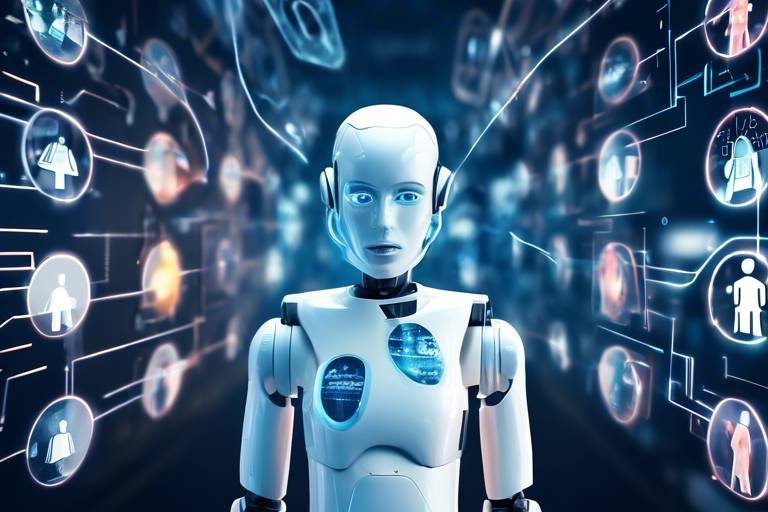Future Work Priorities: The Strategic Imperatives of AI
As we stand on the brink of a new era defined by technological advancements, artificial intelligence (AI) is no longer just a buzzword; it’s a game-changer. Its impact on industries, workforce dynamics, and strategic decision-making is profound and multifaceted. The question isn’t whether AI will transform our work environment, but rather how we can harness its potential to drive innovation and growth. In this article, we’ll explore the essential work priorities shaped by AI, focusing on its transformative effects and the strategic imperatives that organizations must embrace to thrive in this new landscape.
The integration of AI into the workplace is akin to upgrading from a bicycle to a high-speed train. It enhances productivity, streamlines processes, and opens up avenues for creative problem-solving. However, with great power comes great responsibility. As businesses increasingly rely on AI technologies, they must also consider the ethical implications and workforce adjustments necessary for a smooth transition. This article will delve into the various dimensions of AI's impact, offering a comprehensive overview of what organizations need to prioritize moving forward.
One of the most significant shifts brought about by AI is the transformation of workforce skills. As the demand for tech-savvy employees grows, it’s crucial for organizations to foster a culture of continuous learning. Employees must be reskilled and upskilled to adapt to new roles and responsibilities in an AI-driven environment. This isn't just about learning how to use new software; it’s about evolving into a more versatile workforce capable of leveraging AI to enhance their work.
Moreover, understanding which skills will be most valuable in an AI-integrated workplace is essential. Technical skills such as data analysis and programming are becoming increasingly important, but let’s not forget the significance of soft skills. Communication, emotional intelligence, and collaboration are vital for creating a harmonious relationship between humans and AI systems. The future of work will require a delicate balance of both technical prowess and interpersonal skills.
Organizations must implement effective strategies for reskilling their workforce. This can include partnerships with educational institutions, in-house training programs, and mentorship opportunities. By investing in their employees, companies not only enhance their capabilities but also foster loyalty and engagement, which are crucial in retaining top talent.
However, the rise of AI also brings concerns about job displacement. While it's true that AI can automate certain tasks, it can also create new job opportunities that didn't exist before. The challenge lies in managing this transition effectively. Companies need to support displaced workers through retraining programs and job placement services, ensuring that no one is left behind in this technological revolution.
As we navigate through these changes, ethical considerations must also be at the forefront of AI deployment. Issues such as bias in AI systems, privacy concerns, and accountability in automated decision-making need to be addressed. Organizations must strive to develop fair algorithms and implement best practices for protecting sensitive information. This is not just about compliance; it’s about building trust with employees and customers alike.
In conclusion, the strategic imperatives of AI are clear: embrace change, prioritize skills development, and uphold ethical standards. The future of work will be defined by those who can adapt to and leverage AI technologies effectively. It’s an exciting time for innovation and growth, but it also requires a commitment to nurturing a workforce that is ready to meet the challenges of tomorrow.
- What are the main benefits of AI in the workplace? AI enhances productivity, streamlines operations, and fosters innovation.
- How can employees prepare for an AI-driven job market? By focusing on continuous learning and developing both technical and soft skills.
- What ethical concerns should organizations consider when implementing AI? Issues such as bias, privacy, and accountability should be prioritized.
- Will AI lead to job losses? While some roles may be automated, AI also creates new job opportunities and industries.

The Rise of AI in the Workplace
Artificial intelligence is not just a buzzword anymore; it’s a game changer that is dramatically reshaping the landscape of the workplace. Imagine walking into an office where mundane tasks are handled by intelligent systems, allowing employees to focus on creativity and strategic thinking. This is the reality that many industries are beginning to embrace as AI technologies continue to evolve and integrate into daily operations. From automating repetitive tasks to providing data-driven insights, AI enhances productivity and efficiency in ways we could only dream of a decade ago.
Across various sectors, AI is being harnessed to improve decision-making processes and streamline workflows. For instance, in healthcare, AI algorithms analyze patient data to assist doctors in diagnosing conditions more accurately and swiftly. In finance, machine learning models predict market trends, helping investors make informed decisions. Similarly, in manufacturing, AI-driven robots work alongside humans, boosting productivity while ensuring safety and precision. These transformations are not just limited to large corporations; small businesses are also leveraging AI tools to compete in the market, showcasing its versatility and accessibility.
However, the rise of AI in the workplace does not come without challenges. As organizations adopt these technologies, they must also consider the implications for their workforce. Employees may feel apprehensive about job security with the introduction of AI systems. It’s essential for companies to communicate transparently about how AI will be used and to highlight that these technologies are meant to augment human capabilities rather than replace them. By framing AI as a partner in productivity, businesses can foster a culture of innovation and collaboration.
Furthermore, the integration of AI requires a shift in organizational culture. Companies must cultivate an environment that encourages continuous learning and adaptability. This means investing in training programs that not only familiarize employees with AI tools but also empower them to leverage these technologies effectively. As AI continues to evolve, so too must the workforce, adapting to new roles and responsibilities that come with these advancements.
In summary, the rise of AI in the workplace is an exciting development that holds the promise of enhanced efficiency and innovation. As we navigate this transformative era, it’s crucial for organizations to embrace these changes while also prioritizing the well-being and development of their employees. The future of work will not only be about technology but also about how we adapt and thrive in an AI-enhanced world.
- What industries are most affected by AI? Industries such as healthcare, finance, manufacturing, and retail are experiencing significant transformations due to AI integration.
- Will AI take away jobs? While AI may automate certain tasks, it also creates new job opportunities that require human skills, fostering job evolution rather than outright elimination.
- How can employees prepare for an AI-driven workplace? Employees can enhance their skills through continuous learning, focusing on both technical and soft skills to remain relevant in an evolving job market.
- What role does ethics play in AI deployment? Ethical considerations are critical to ensure fairness, accountability, and transparency in AI systems, addressing potential biases and protecting user privacy.

Transforming Workforce Skills
As artificial intelligence (AI) continues to penetrate various sectors, the demand for new skills in the workforce is becoming increasingly apparent. The traditional job landscape is undergoing a seismic shift, and it's essential for both employees and employers to recognize the urgency of adapting to these changes. Imagine trying to navigate a bustling city without a map; that's what it's like for professionals who are not equipped with the right skills in an AI-driven world. The reality is that the **skills needed today** are not the same as those required just a few years ago, and this transformation is only going to accelerate.
In this evolving environment, the emphasis on reskilling and upskilling cannot be overstated. Organizations must invest in their workforce to ensure that employees are not only keeping pace with technological advancements but are also prepared to leverage these tools effectively. This means creating a culture of continuous learning where employees feel empowered to seek out new knowledge and skills. For instance, companies can implement training programs that focus on both technical skills—like data analysis and programming—and soft skills, which are equally crucial for collaboration and communication in a tech-driven workspace.
To better illustrate the changing landscape of workforce skills, consider the following table that highlights key competencies needed in the AI era:
| Skill Type | Examples | Importance |
|---|---|---|
| Technical Skills | Data Analysis, Machine Learning, Programming | Essential for working with AI technologies and data-driven decision-making. |
| Soft Skills | Communication, Emotional Intelligence, Adaptability | Crucial for effective teamwork and human-AI interaction. |
| Creative Skills | Problem-Solving, Innovation, Design Thinking | Important for developing new solutions and approaches in a rapidly changing environment. |
Understanding which skills will be most valuable is a critical step for individuals aiming to remain competitive in this new landscape. Not only do professionals need to be technically savvy, but they must also possess a range of soft skills to collaborate effectively with AI systems. Think of it like a dance; both partners need to be in sync to create something beautiful. In this case, humans and AI must work together harmoniously to maximize productivity and innovation.
Moreover, organizations have a responsibility to facilitate this transformation. By implementing robust training programs, fostering partnerships with educational institutions, and encouraging a culture of knowledge sharing, companies can help their employees navigate this new terrain. The goal is to create a workforce that is not just reactive to changes but is proactive in seeking out opportunities for growth and development. This is not just about survival; it's about thriving in a world where AI is an integral part of the work environment.
As we look to the future, it’s clear that the skills landscape will continue to evolve. The question is, are you ready to adapt? Embracing this change will not only enhance individual careers but will also drive organizational success in the age of AI.
- What are the most important skills to develop for the future workplace?
Technical skills such as data analysis and programming, along with soft skills like communication and emotional intelligence, are vital. - How can organizations support employee reskilling?
Organizations can implement training programs, partner with educational institutions, and create a culture of continuous learning. - Why are soft skills important in an AI-driven environment?
Soft skills facilitate effective collaboration between humans and AI systems, which is essential for maximizing productivity.

Identifying Key Skills for the Future
As we stride into an era dominated by artificial intelligence, identifying the key skills that will define the future workforce becomes a critical task. In a world where machines increasingly collaborate with humans, the ability to adapt and thrive in this new environment is more important than ever. So, what exactly are these skills that will set individuals apart in an AI-driven landscape? Let’s dive in!
First and foremost, technical skills are essential. These encompass a range of competencies that allow professionals to interact effectively with AI systems. For instance, data analysis is a skill that will be in high demand. As organizations amass more data than ever, the ability to interpret and derive actionable insights from this data will be invaluable. Similarly, skills in programming, particularly in languages like Python and R, will enable individuals to develop and refine AI applications. Just think of it as learning a new language; the more fluent you are, the better you can communicate with the machine!
However, it’s not just about technical prowess. The future workplace will also demand a robust set of soft skills. These are the interpersonal skills that facilitate effective collaboration between humans and AI. For instance, communication will be paramount. As teams become more diverse, with AI systems included, the ability to articulate ideas clearly and concisely will help bridge the gap between human insight and machine efficiency. Moreover, emotional intelligence will play a crucial role. Understanding and managing emotions, both one’s own and those of others, will foster a more harmonious work environment where humans and AI can coexist and collaborate effectively.
To summarize, the key skills for the future workforce can be categorized into two main areas:
| Skill Type | Examples |
|---|---|
| Technical Skills | Data Analysis, Programming (Python, R), Machine Learning |
| Soft Skills | Communication, Emotional Intelligence, Adaptability |
In conclusion, as we navigate this transformative era, a blend of both technical and soft skills will be crucial for success. Individuals who invest time in developing these competencies will not only enhance their employability but will also position themselves as leaders in the AI-integrated workplace. The future is bright for those who are willing to evolve!
- What are the most important skills to learn for an AI-driven job market?
The most important skills include data analysis, programming, communication, and emotional intelligence.
- How can I start developing these skills?
You can start by taking online courses, attending workshops, and engaging in collaborative projects that involve AI technologies.
- Are soft skills really that important in a tech-driven world?
Absolutely! Soft skills facilitate teamwork and communication, which are essential for successful collaboration between humans and AI.

Technical Skills in Demand
In today’s fast-paced, technology-driven world, the demand for technical skills is soaring, especially in the realm of artificial intelligence (AI). As organizations increasingly embrace AI to enhance their operations, professionals must equip themselves with the right skills to stay relevant and competitive. The landscape of required technical skills is evolving, and understanding these changes is crucial for anyone looking to thrive in an AI-integrated workplace.
One of the most sought-after technical skills is data analysis. Companies are inundated with data, and the ability to analyze this data effectively can lead to informed decision-making and strategic advantages. Professionals who can interpret complex datasets and draw actionable insights are invaluable. Additionally, proficiency in programming languages such as Python and R is becoming essential. These languages are widely used in AI development and data manipulation, making them critical for anyone wanting to work in this space.
Another key area of focus is machine learning. As AI systems become more sophisticated, the understanding of machine learning algorithms and frameworks is increasingly important. Professionals who can design, implement, and optimize machine learning models will find themselves in high demand. Furthermore, knowledge of cloud computing platforms, like AWS and Azure, is also crucial, as many AI applications are deployed in the cloud to leverage scalability and flexibility.
To illustrate the technical skills that are currently in demand, consider the following table:
| Technical Skill | Description | Importance |
|---|---|---|
| Data Analysis | Ability to interpret and analyze data to inform business decisions. | High |
| Programming (Python, R) | Writing code to develop software and manipulate data. | High |
| Machine Learning | Understanding algorithms and building predictive models. | Critical |
| Cloud Computing | Using cloud services to deploy and scale AI applications. | Essential |
In addition to these technical skills, knowledge of cybersecurity is becoming increasingly important as organizations adopt AI technologies. With the rise of data breaches and cyber threats, professionals who can ensure the security of AI systems will be highly valued. DevOps skills are also gaining traction, as they facilitate collaboration between development and IT operations, ensuring that AI applications are deployed smoothly and efficiently.
In conclusion, the future of work in an AI-driven environment demands a robust set of technical skills. As industries continue to evolve, professionals must prioritize their learning and development in areas such as data analysis, programming, machine learning, and cloud computing. By doing so, they can position themselves as indispensable assets in their organizations, ready to tackle the challenges and opportunities that AI presents.
- What are the most important technical skills for AI?
Data analysis, programming, machine learning, and cloud computing are among the top technical skills needed in the AI landscape. - How can I develop these technical skills?
Consider enrolling in online courses, attending workshops, and seeking certifications in relevant fields to enhance your technical capabilities. - Is programming necessary for a career in AI?
Yes, programming is essential, particularly in languages like Python and R, which are widely used in AI development. - What role does data analysis play in AI?
Data analysis is crucial for interpreting data and making informed decisions based on AI-generated insights.

Soft Skills for Human-AI Collaboration
As we dive deeper into the realm of artificial intelligence, it becomes increasingly clear that soft skills are not just complementary to technical know-how; they are essential for fostering effective collaboration between humans and AI systems. Imagine a world where machines can analyze data faster than a human can blink, but lack the ability to understand the nuances of human emotion or context. This is where soft skills come into play, bridging the gap between human insight and machine efficiency.
In an AI-driven workplace, communication stands out as a cornerstone of successful collaboration. It’s not just about conveying information; it’s about understanding the context and intent behind that information. For instance, when a team is working with AI tools, clear communication ensures that the insights generated by AI are interpreted correctly and applied effectively. This is particularly important in areas like healthcare, where a misinterpretation can have serious consequences.
Moreover, emotional intelligence is another critical soft skill that enhances human-AI interaction. This skill enables individuals to recognize their own emotions and those of others, fostering a more empathetic approach to technology. Imagine a customer service AI that can detect frustration in a user's voice. A human operator with high emotional intelligence can step in to provide the necessary support, ensuring a seamless experience. This kind of synergy between human empathy and AI efficiency can significantly improve customer satisfaction and loyalty.
Collaboration also requires a strong sense of adaptability. The landscape of AI is ever-evolving, and so too are the tools and technologies that accompany it. Workers must be willing to embrace change and learn new ways to work alongside AI systems. This adaptability not only enhances productivity but also encourages a culture of continuous improvement within organizations.
To sum it up, the integration of AI into the workplace is not just a technical challenge; it’s a human challenge. The soft skills of communication, emotional intelligence, and adaptability are crucial for leveraging the full potential of AI technologies. As we move forward, organizations must prioritize the development of these skills alongside technical training to ensure a harmonious and productive working environment.
- Why are soft skills important in an AI-driven workplace?
Soft skills help bridge the gap between human insight and AI capabilities, ensuring effective communication and collaboration. - What role does emotional intelligence play in working with AI?
Emotional intelligence allows individuals to understand and manage emotions, enhancing interactions with AI systems and improving overall outcomes. - How can organizations foster soft skills among employees?
Organizations can implement training programs, workshops, and collaborative projects that emphasize the development of soft skills alongside technical training.

Strategies for Reskilling and Upskilling
In today's fast-paced world, where artificial intelligence is becoming an integral part of the workplace, organizations face a pressing challenge: how to effectively reskill and upskill their workforce. This is not merely a trend; it's a necessity for survival in an increasingly competitive landscape. Companies must adopt strategies that not only equip employees with new skills but also foster a culture of continuous learning. So, how can organizations tackle this? Let's dive into some effective strategies.
One of the most effective methods is through the implementation of training programs. These programs can be tailored to meet the specific needs of the organization and its employees. By focusing on the skills that are most relevant to the AI technologies being adopted, companies can ensure that their workforce remains competent and competitive. For example, offering workshops on data analysis or machine learning can empower employees to navigate and leverage AI tools effectively.
Another crucial strategy involves creating partnerships with educational institutions. Collaborating with universities and training centers can provide employees access to cutting-edge courses and certifications. This not only enhances their skill set but also instills a sense of loyalty and motivation among employees, as they see their employer investing in their future. Furthermore, organizations can consider offering tuition reimbursement programs, encouraging employees to pursue further education while reducing the financial burden.
Additionally, fostering a culture of mentorship within the organization can significantly enhance reskilling efforts. By pairing experienced employees with those looking to acquire new skills, companies can create an environment of knowledge sharing and collaboration. This mentorship approach not only helps in skill development but also strengthens team dynamics and enhances overall workplace morale.
Moreover, organizations should leverage technology to facilitate learning. Online learning platforms and e-learning modules can provide employees with the flexibility to learn at their own pace. This is particularly beneficial in an AI-driven environment where the need for quick adaptation is paramount. Companies can create a library of resources, including video tutorials, webinars, and interactive courses, making learning accessible and engaging.
To ensure that these strategies are effective, it is essential for organizations to regularly assess their workforce's skills and identify gaps. Conducting skills assessments can help pinpoint areas that require immediate attention and align training programs accordingly. This proactive approach not only benefits the organization but also empowers employees to take charge of their own career development.
In summary, the strategies for reskilling and upskilling in an AI-driven workplace are multifaceted. By implementing tailored training programs, partnering with educational institutions, fostering mentorship, leveraging technology, and conducting regular skills assessments, organizations can create a robust framework for continuous learning. This not only prepares employees for the challenges of the future but also positions the organization for sustained growth and innovation.
- What is the importance of reskilling and upskilling in the workplace?
Reskilling and upskilling are crucial as they help employees adapt to changes in technology, particularly with the rise of AI, ensuring they remain relevant and competitive in their roles. - How can companies assess the skills of their employees?
Companies can conduct regular skills assessments through surveys, performance reviews, and feedback sessions to identify areas where employees may need additional training or support. - What role do mentorship programs play in employee development?
Mentorship programs facilitate knowledge sharing and provide employees with guidance and support, helping them acquire new skills and navigate their career paths more effectively. - Are online learning platforms effective for employee training?
Yes, online learning platforms offer flexibility and a wide range of resources that can cater to different learning styles, making them an effective tool for employee training and development.

AI's Impact on Job Creation and Displacement
As we stand on the brink of a new era dominated by artificial intelligence, the conversation around its impact on job creation and displacement is more relevant than ever. While many fear that AI will take away jobs, the reality is a bit more nuanced. It’s not just about machines replacing human labor; it’s about how AI is reshaping the job landscape entirely. Think of it as a double-edged sword—while some jobs may vanish, new ones are born from the ashes of the old. This transformation is akin to the industrial revolution, where technology replaced certain roles but also created entirely new industries and opportunities.
To understand the full scope of AI's impact, we must delve into both sides of the coin. On one hand, automation powered by AI can lead to job displacement, particularly in repetitive and manual tasks. For instance, roles in manufacturing, data entry, and even customer service are increasingly being automated. According to a report by the World Economic Forum, it is estimated that by 2025, machines and algorithms will displace around 85 million jobs globally. However, this same report also highlights that approximately 97 million new roles may emerge, particularly in areas that require human creativity, emotional intelligence, and complex problem-solving skills.
But what kinds of jobs are we talking about? The new opportunities created by AI are diverse and span various sectors. Here are some of the emerging roles that are gaining traction:
- AI Ethics Compliance Officer: As AI systems become more complex, organizations will need professionals who ensure ethical compliance in AI deployment.
- Data Analysts: With the surge in data generation, skilled data analysts will be in high demand to interpret and leverage this information effectively.
- AI Trainers: These individuals will be responsible for training AI systems, ensuring they learn accurately and effectively.
- AI Maintenance Specialists: As AI systems become integral to operations, the need for professionals who can maintain and troubleshoot these systems will grow.
Moreover, industries such as healthcare, education, and finance are seeing a significant influx of AI-driven roles that require a blend of technical expertise and human-centric skills. For example, in healthcare, AI is transforming diagnostics and patient care, creating roles for professionals who can interpret AI-generated insights and apply them in clinical settings.
Now, let’s not forget about the human aspect of this transition. Managing workforce displacement is crucial to ensuring that individuals affected by automation can successfully navigate their career paths. Organizations must adopt comprehensive strategies to support their employees, which may include:
- Retraining programs to help workers acquire new skills.
- Job placement services to connect displaced workers with new opportunities.
- Partnerships with educational institutions to offer continuous learning and upskilling.
In essence, while AI does pose challenges concerning job displacement, it simultaneously opens the door to a plethora of new opportunities. The key lies in how we, as a society, choose to respond to these changes. By prioritizing education and reskilling, we can harness the potential of AI to not only create jobs but also enrich the workforce with new skills and capabilities.
Q1: Will AI really take away my job?
A1: While AI may automate certain tasks, it also creates new job opportunities. The key is to adapt and learn new skills that complement AI technologies.
Q2: What types of jobs will be created due to AI?
A2: Jobs in AI ethics, data analysis, AI training, and maintenance are just a few examples of roles that are emerging as AI technology advances.
Q3: How can I prepare for the changes brought by AI?
A3: Focus on developing both technical skills related to AI and soft skills like communication and emotional intelligence, which are invaluable in an AI-driven workplace.

New Job Opportunities in AI
As artificial intelligence continues to permeate various sectors, it’s not just about job displacement; it’s also about the exciting new opportunities that are emerging. Think of AI as a powerful engine driving innovation, creating roles that didn’t even exist a decade ago. For instance, roles such as AI Ethicist and Machine Learning Engineer are becoming increasingly vital in organizations striving to harness AI responsibly and effectively.
In the realm of healthcare, AI is revolutionizing patient care and operational efficiency. New job categories like Health Data Analyst and AI Healthcare Consultant are gaining traction, as healthcare providers look to leverage data-driven insights to improve outcomes. Similarly, the financial sector is seeing a surge in demand for AI Financial Analysts who can interpret complex algorithms and provide strategic insights based on predictive analytics.
Moreover, the tech industry is at the forefront of this transformation, with roles such as Robotics Engineer and AI Product Manager becoming essential. These professionals are tasked with developing and managing AI-driven products that can enhance user experience and operational efficiency. It's akin to being a conductor of a grand symphony, where each section must harmonize perfectly to create a masterpiece.
To illustrate the variety of opportunities available, let’s take a look at a few emerging job roles in AI:
| Job Title | Description | Industry |
|---|---|---|
| AI Ethicist | Ensures ethical considerations are integrated into AI systems. | Various |
| Machine Learning Engineer | Designs and implements machine learning applications. | Tech |
| Health Data Analyst | Analyzes healthcare data to improve patient outcomes. | Healthcare |
| AI Financial Analyst | Utilizes AI to analyze market trends and financial data. | Finance |
As we venture further into this AI-driven age, it’s crucial for job seekers to stay ahead of the curve. The key will be to embrace lifelong learning and remain adaptable. Organizations are not just looking for technical skills; they also value creativity and critical thinking. It’s a bit like being a modern-day alchemist, where the ability to transform knowledge into innovative solutions can lead to incredible new possibilities.
In conclusion, while the narrative around AI often revolves around fears of job loss, it’s essential to recognize the vast landscape of new roles that are emerging. With the right skills and mindset, individuals can seize these opportunities and pave the way for a fulfilling career in an AI-enhanced world.
1. What types of jobs are being created due to AI?
AI is creating a wide range of new job roles, including AI Ethicists, Machine Learning Engineers, Health Data Analysts, and AI Financial Analysts, among others.
2. How can I prepare for a career in AI?
To prepare for a career in AI, focus on acquiring both technical skills, such as programming and data analysis, as well as soft skills like communication and problem-solving.
3. Are there opportunities for reskilling in AI?
Yes, many organizations offer training programs and partnerships with educational institutions to help employees reskill and adapt to new roles in an AI-driven environment.
4. How does AI impact job security?
While AI may displace some jobs, it also creates new opportunities. Individuals who adapt and learn new skills will likely find themselves in demand in the evolving job market.

Managing Workforce Transition
Transitioning a workforce amidst the rise of artificial intelligence is not just a challenge; it's an opportunity for organizations to redefine their value proposition. As AI systems become more integrated into daily operations, companies face the daunting task of managing the workforce shift that accompanies these changes. The key lies in understanding that while AI can automate certain tasks, it also opens the door for new roles that require a different set of skills. This duality is where effective transition management becomes crucial.
To navigate this transition smoothly, organizations need to adopt a proactive approach. This includes implementing comprehensive retraining programs that focus not only on technical skills but also on enhancing soft skills. For instance, employees who were once engaged in manual data entry might find themselves in roles that require them to interpret data insights and collaborate with AI systems. Therefore, organizations should prioritize training that empowers employees to adapt to these evolving roles.
Moreover, offering job placement services can significantly alleviate the anxiety that comes with potential job displacement. By providing support in identifying new career opportunities, organizations can foster a culture of trust and loyalty among their employees. This support can take many forms, such as:
- Career counseling sessions to help employees explore new paths.
- Partnerships with local businesses to create job placement opportunities.
- Access to online learning platforms that provide courses aligned with market demands.
Another critical aspect of managing workforce transition is maintaining open lines of communication. Regularly updating employees about the changes taking place and how they will be affected can help mitigate fears and uncertainties. Transparency fosters a sense of belonging and encourages employees to engage with the transition process actively.
Additionally, organizations should consider forming cross-functional teams that include employees from various departments. This collaborative approach not only helps in sharing knowledge and skills but also encourages innovation as employees work together to solve problems that arise from AI integration. By involving employees in the transition process, organizations can harness their insights and creativity, leading to more effective solutions.
In summary, managing workforce transition in the age of AI requires a multifaceted strategy that encompasses training, support, communication, and collaboration. By focusing on these areas, organizations can not only ease the transition for their employees but also position themselves for future success in an increasingly automated world.
Q: How can companies ensure that their employees are adequately reskilled for new roles?
A: Companies can implement tailored training programs that focus on both the technical and soft skills required for new roles. Collaborating with educational institutions and utilizing online learning platforms can enhance reskilling efforts.
Q: What role does communication play in managing workforce transitions?
A: Open and transparent communication helps alleviate employee fears and uncertainties. Regular updates about changes and how they will impact employees foster a sense of trust and belonging.
Q: Are there specific job roles that are emerging due to AI integration?
A: Yes, roles such as AI trainers, data analysts, and machine learning specialists are becoming increasingly important as organizations adopt AI technologies. These positions require a blend of technical expertise and the ability to work collaboratively with AI systems.

Ethical Considerations in AI Deployment
As artificial intelligence (AI) becomes more integrated into our daily lives and workplaces, it brings with it a myriad of ethical considerations that cannot be overlooked. The deployment of AI technologies raises critical questions about fairness, accountability, and the potential for bias in automated systems. For instance, how do we ensure that AI systems make decisions that are not only efficient but also just? The answers to these questions are vital for maintaining trust in AI technologies and ensuring their responsible use.
One of the primary ethical concerns surrounding AI is bias. AI systems learn from data, and if that data contains historical biases, the AI can perpetuate and even amplify these biases. This can lead to unfair treatment of individuals based on race, gender, or socioeconomic status. For example, consider a hiring algorithm trained on historical hiring data that favored certain demographics. If not carefully monitored, such an AI could unfairly disadvantage qualified candidates from underrepresented groups. Therefore, organizations must prioritize the development of fair algorithms and implement rigorous testing to identify and mitigate bias in their AI systems.
Moreover, the issue of privacy and data security is paramount in the conversation about AI ethics. With the increasing use of AI comes the collection of vast amounts of personal data, raising concerns about how this data is used and protected. Organizations must establish clear guidelines and best practices to safeguard sensitive information while leveraging AI technologies. This includes ensuring that data is anonymized where possible and that individuals are informed about how their data is being utilized. A transparent approach not only builds trust but also aligns with ethical standards that prioritize user privacy.
Accountability is another critical aspect of ethical AI deployment. As AI systems make more autonomous decisions, determining who is responsible for those decisions becomes increasingly complex. Organizations must establish clear accountability frameworks that define the roles and responsibilities of both human operators and AI systems. This ensures that if an AI system makes a mistake or causes harm, there is a clear pathway for addressing the issue and holding the appropriate parties accountable.
To summarize, the ethical considerations in AI deployment are multifaceted and require a comprehensive approach. Organizations should focus on:
- Developing fair algorithms to mitigate bias.
- Implementing robust data privacy and security measures.
- Establishing clear accountability frameworks for AI decision-making.
By addressing these ethical concerns head-on, organizations can harness the power of AI while ensuring that their deployment aligns with societal values and promotes equity. As we move forward into an AI-driven future, it is crucial to engage in ongoing discussions about the ethical implications of these technologies, ensuring that they serve to enhance human capabilities rather than undermine them.
Q1: What are the main ethical concerns related to AI?
A1: The main ethical concerns include bias in AI systems, privacy and data security issues, and accountability for AI decision-making.
Q2: How can organizations mitigate bias in AI?
A2: Organizations can mitigate bias by developing fair algorithms, conducting thorough testing of AI systems, and using diverse datasets to train AI models.
Q3: Why is accountability important in AI deployment?
A3: Accountability is important to ensure that there is a clear understanding of who is responsible for AI decisions, especially in cases where those decisions lead to negative outcomes.
Q4: How can organizations protect user privacy in AI?
A4: Organizations can protect user privacy by anonymizing data, being transparent about data usage, and implementing strong data security measures.

Addressing Bias in AI Systems
In today's rapidly evolving digital landscape, artificial intelligence (AI) systems are becoming integral to decision-making processes across various industries. However, one of the most pressing issues that has surfaced is the potential for bias within these systems. Bias in AI can lead to unfair outcomes, perpetuating stereotypes and discrimination, which can have far-reaching consequences for businesses and society as a whole. So, how do we tackle this complex challenge?
First and foremost, it is essential to recognize that bias can enter AI systems at multiple stages, from data collection to algorithm design. For instance, if the training data used to develop an AI model is not representative of the diverse population it serves, the resulting model may produce skewed outcomes. This is akin to trying to bake a cake with only half the ingredients; the final product will not reflect the intended recipe. Therefore, ensuring diverse and representative datasets is crucial in minimizing bias.
Organizations must also focus on developing algorithms that are transparent and interpretable. By understanding how AI systems make decisions, stakeholders can identify potential biases and rectify them. This process can be compared to reading a recipe before cooking; knowing the steps involved allows for adjustments to be made if something doesn’t seem right. Transparency in AI systems can be achieved through techniques such as explainable AI (XAI), which helps demystify the decision-making process.
Moreover, organizations should implement regular audits of their AI systems to monitor for bias. These audits can serve as a checkpoint, ensuring that AI applications remain fair and equitable over time. It's not enough to set up a system and forget about it; continuous evaluation is necessary to adapt to changing societal norms and values. By regularly reviewing AI systems, organizations can adapt to new findings and societal changes, ensuring that their AI applications evolve alongside the communities they serve.
Additionally, fostering a culture of diversity and inclusion within AI development teams is vital. Diverse teams bring a variety of perspectives, which can help identify biases that a homogeneous group might overlook. This is similar to having a group of friends with different tastes in music; together, they can create a playlist that appeals to a broader audience. By promoting diversity in AI development, organizations can create more robust and fair systems.
Finally, engaging with stakeholders, including affected communities, is essential in addressing bias in AI systems. By involving those who are impacted by AI decisions, organizations can gain insights into potential biases and work collaboratively to find solutions. Listening to the voices of those who may be marginalized can illuminate hidden biases that developers may not be aware of, leading to more equitable outcomes.
In conclusion, addressing bias in AI systems is not just a technical challenge; it's a moral imperative. By focusing on diverse datasets, transparent algorithms, regular audits, inclusive teams, and stakeholder engagement, organizations can build AI systems that are fair and just. This approach not only benefits individuals and communities but also enhances the credibility and effectiveness of AI technologies in the long run.
- What is bias in AI? Bias in AI refers to systematic favoritism or discrimination that can occur in AI systems, often due to unrepresentative training data or flawed algorithms.
- How can organizations minimize bias in AI? Organizations can minimize bias by using diverse datasets, ensuring transparency in algorithms, conducting regular audits, and fostering inclusive teams.
- Why is diversity important in AI development? Diversity in AI development teams helps identify and mitigate biases that may be overlooked by a homogeneous group, leading to fairer AI systems.
- What role do stakeholders play in addressing bias? Engaging with stakeholders allows organizations to understand the impacts of their AI systems and collaboratively work towards equitable solutions.

Ensuring Privacy and Security
As artificial intelligence continues to weave its way into the fabric of our workplaces, the importance of privacy and security cannot be overstated. With AI systems processing vast amounts of sensitive data, organizations must be vigilant in safeguarding this information. Imagine a bustling city where every street corner has a surveillance camera; while it can enhance security, it also raises questions about who is watching and how that data is used. In the same vein, AI technology can offer incredible insights, but it can also expose vulnerabilities if not managed properly.
To ensure that privacy and security are prioritized, organizations should adopt a multifaceted approach. This involves not only implementing robust technical measures but also fostering a culture of awareness among employees. For instance, regular training sessions can help staff understand the importance of data protection and the potential risks associated with AI deployment. Additionally, companies should establish clear guidelines regarding data usage, ensuring that employees are aware of their responsibilities in handling sensitive information.
Moreover, organizations must consider the following best practices to enhance privacy and security:
- Data Encryption: Encrypting data both at rest and in transit helps protect sensitive information from unauthorized access.
- Access Controls: Implementing strict access controls ensures that only authorized personnel can access sensitive data.
- Regular Audits: Conducting regular security audits can identify vulnerabilities and ensure compliance with data protection regulations.
- Incident Response Plans: Developing a robust incident response plan prepares organizations for potential data breaches, enabling them to respond swiftly and effectively.
In addition to these practices, organizations should also stay informed about the evolving landscape of data protection laws and regulations. With the introduction of regulations such as the General Data Protection Regulation (GDPR) in Europe and various state-level laws in the United States, compliance is not just a legal obligation but a critical component of maintaining trust with customers and employees alike.
Ultimately, ensuring privacy and security in an AI-driven workplace is not merely a checkbox on a compliance form; it’s about cultivating a sense of trust and responsibility. When employees feel that their data is handled with care, they are more likely to engage fully with AI technologies, paving the way for innovation and growth. As we look to the future, let’s make privacy and security a priority, ensuring that as we embrace AI, we do so with respect for the individuals behind the data.
Q1: What measures can organizations take to protect employee data when using AI?
A1: Organizations can implement data encryption, access controls, regular audits, and incident response plans to protect employee data when using AI.
Q2: How can organizations ensure compliance with data protection regulations?
A2: Staying informed about evolving data protection laws and conducting regular compliance audits can help organizations ensure adherence to regulations.
Q3: Why is employee training important in the context of AI and data security?
A3: Employee training raises awareness about data protection, helping staff understand their responsibilities and the potential risks associated with AI deployment.
Frequently Asked Questions
- How is AI transforming the workplace?
AI is revolutionizing the workplace by enhancing productivity and efficiency across various industries. It automates routine tasks, allowing employees to focus on more strategic and creative aspects of their jobs. This shift not only improves operational efficiency but also fosters innovation by enabling teams to leverage data-driven insights for better decision-making.
- What skills are essential for the future workforce in an AI-driven environment?
As AI continues to evolve, both technical and soft skills are becoming increasingly important. Key technical skills include data analysis, programming, and machine learning, while soft skills such as communication, emotional intelligence, and adaptability are crucial for effective collaboration between humans and AI systems. These competencies will help professionals thrive in an AI-integrated workplace.
- What strategies can organizations implement for reskilling their workforce?
Organizations can adopt various strategies for reskilling, including offering targeted training programs, partnering with educational institutions, and creating mentorship opportunities. Continuous learning initiatives, such as workshops and online courses, can also help employees adapt to new technologies and roles, ensuring they remain competitive in the job market.
- Will AI lead to job displacement or job creation?
While there are concerns about job displacement due to automation, AI also creates new job opportunities in emerging fields. As industries evolve, new roles will arise that require human oversight and creativity. It's essential to manage workforce transitions effectively, providing support and retraining for displaced workers to help them navigate their career changes.
- What ethical considerations should be taken into account when deploying AI in the workplace?
Ethical considerations in AI deployment include addressing bias in algorithms, ensuring privacy and data security, and maintaining accountability in automated decision-making. Organizations must strive to develop fair and transparent AI systems while implementing best practices to protect sensitive information and uphold ethical standards.
- How can organizations mitigate bias in AI systems?
To mitigate bias in AI systems, organizations should focus on developing diverse datasets and regularly auditing their algorithms for fairness. Implementing guidelines for ethical AI development and involving multidisciplinary teams in the design process can also help identify and address potential biases before they impact decision-making.
- What best practices should be followed to ensure privacy and security with AI technologies?
Best practices for ensuring privacy and security with AI include implementing robust data protection measures, conducting regular security audits, and adhering to compliance regulations. Organizations should also educate employees about data handling practices and establish clear protocols for managing sensitive information when using AI technologies.



















